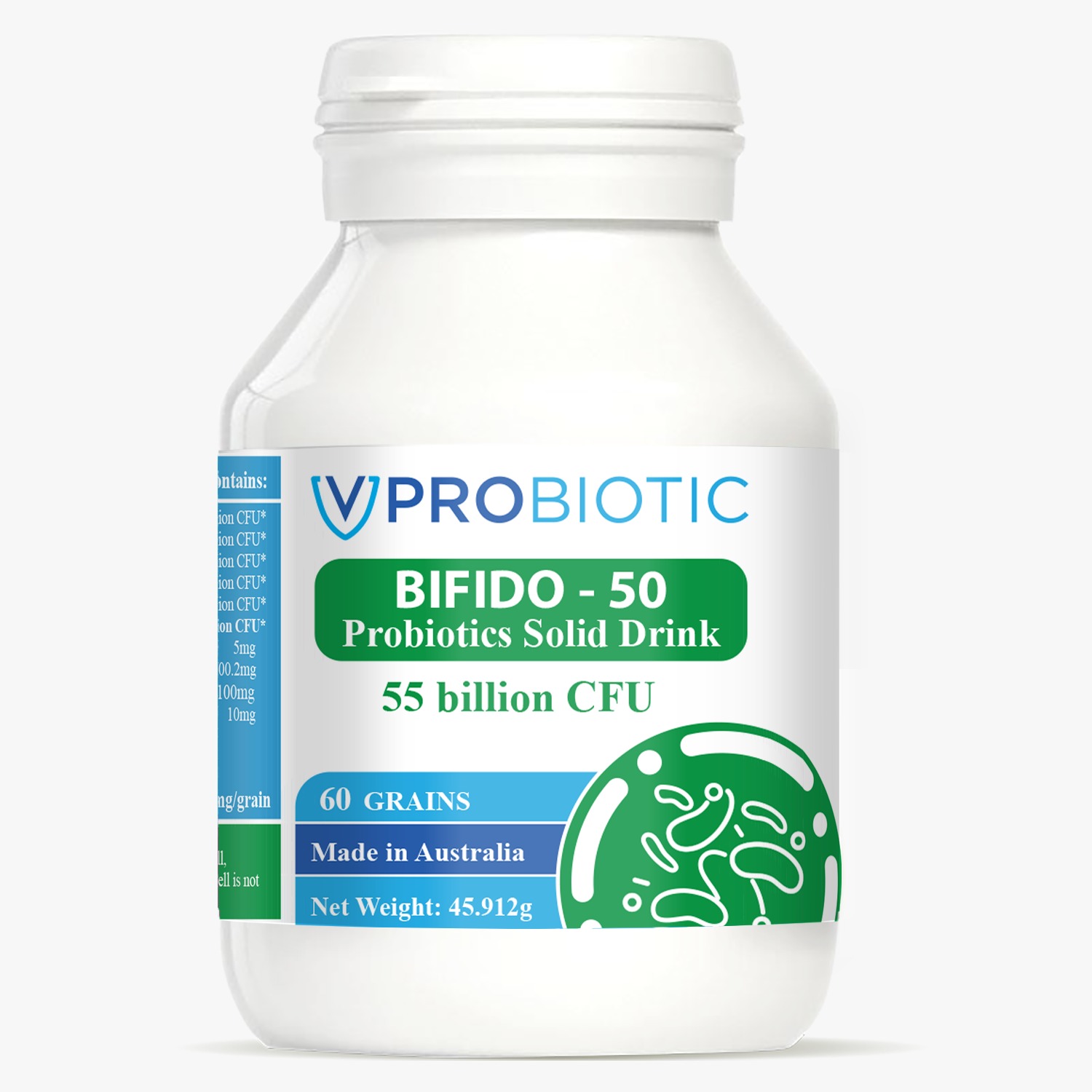
BIFIDO-50
PROBIOTICS CAPSULES
30s/60s
The levels of beneficial bacteria in the gut of the elderly are lower, especially the beneficial bacteria of the Bifidobacterium genus. According to research, the number of these beneficial bacteria plummets by 1,000 times from the age of 55 to 60. This imbalance of good and bad bacteria in the gut is an important reason older adults are more susceptible to stomach and intestinal infections. The researchers found that daily supplementation with this particular strain improved cognitive function in older adults, including memory and concentration.
INGREDIENTS
| Each capsule contains: | |
| Bifidobacterium infantis | 15 billion CFU* |
| Bifidobacterium longum | 10 billion CFU* |
| Bifidobacterium bifidum | 10 billion CFU* |
| Bifidobacterium breve | 10 billion CFU* |
| Bifidobacterium animalis | 10 billion CFU* |
| Total | 55 billion CFU* |
| Mushroom powder (contain: Vitamins D3 400IU) | 5mg |
| Spirulina platensis (contain: Folic Acid 200mcg) | 200mcg |
| Spirulina powder | 100mg |
| Galacto-Oligosaccharides (prebiotic) | 100mg |
| * CFU: Colony Forming Units |
HOW TO EAT:
Adults take 1 vegetarian capsule daily with water, or as directed by your health professional.
WARNINGS:
Do not consume if the label seal around cap is broken or removed.
STORAGE INSTRUCTIONS:
Store in a dry place away from direct sunlight. Use within 3 months of opening. No refrigeration required. Keep out of reach of children.
Make sure to take BIFIDO-50 at least two hours before or after taking antibiotics.

KEY BENEFITS
- Enhance immune function
- Improvement of symptoms such as constipation
- Reduces discomfort for IBS patients
- Improve cholesterol levels and lower blood pressure
- Prevent diarrhea caused by antibiotics
L. = Lactobacillus
Mostly found in such as the digestive system, urinary system, and genital system
B. = Bifidobacterium
Bifidobacteria are one of the major of bacteria that make up the gastrointestinal tract
S. = Streptococcus thermophilus
Streptococcus thermophilus is a type of probiotic (“good” bacteria) found in the digestive tract. It produces lactic acid in the gut.
CFU = Colony Forming Units
Unit of measurement used for probiotics and other bacteria.
BIFIDO - 50 FAQS
Does Bifidobacterium reduce inflammation?
Anti-inflammatory Bifidobacterium strains prevent dextran sodium sulfate induced colitis and associated gut microbial dysbiosis in mice.
Which is better Lactobacillus or Bifidobacterium?
While both Bifidobacterium and Lactobacilli bacteria share metabolic properties, Lactobacilli have a much higher level of phylogenetic, phenotypic, and ecological diversity and have over 170 recognized species.
How can I increase Bifidobacterium in my gut?
Summary: You can increase Bifidobacteria by eating fiber-rich foods such as fruit, vegetables and whole grains. You can also take probiotics that contain the bacteria.
What happens if you don’t have enough Bifidobacterium?
This word simply means that the composition of your gut microbiome is unbalanced. It can cause digestive problems like gas, cramps, and diarrhoea. Moreover, an unbalanced ecosystem can contribute to chronic low-grade inflammation of the gut lining that is linked to many diseases outside the gut.
How long does it take for Bifidobacterium to work?
You also don’t want to waste money taking probiotic products that don’t have any health benefits for you. Based on my observation in the clinic, some patients notice the benefits of probiotics as soon as 1-3 days. For others, it takes as long as 2-3 weeks to see the effects of probiotic supplementation.
Can you have too much Bifidobacterium?
It takes a very high dose of bifidobacteria to cause any adverse reaction in most people more than you’d get from a food-based source and healthy people should experience only mild discomfort from taking too much.
Does Bifidobacterium cause weight gain?
Several strains of probiotics in both the Lactobacillus and Bifidobacterium family have been shown to reduce weight and belly fat.
Should Bifidobacterium be taken before or after food?
On the other hand, Lactobacillus and Bifidobacterium survive best when taken up to 30 minutes before a meal.
Does Bifidobacterium cause constipation?
Although the human microbiome comprises more than 400 bacterial species, evidence has shown that a decrease in the population of Bifidobacterium and Lactobacillus in adults can result in intestinal constipation.
What causes low Bifidobacterium?
Many diseases are associated with low numbers of Bifidobacteria in the intestines. For example, studies have shown that people with celiac disease, obesity, diabetes, allergic asthma and dermatitis all appear to have lower levels of Bifidobacteria in their intestines compared to healthy people.
What does low Bifidobacterium mean?
Low Bifidobacterium Abundance in the Lower Gut Microbiota Is Associated With Helicobacter pylori-Related Gastric Ulcer and Gastric Cancer.
What is the best way to increase Bifidobacterium?
All fermented foods are sources of Bifidobacteria, particularly milk kefir, sourdough bread, sauerkraut, kimchi and other fermented vegetables. Fermented foods containing lactic acid bacteria, such as cultured milk and yoghurt products, have been found to increase levels of Bifidobacteria and Lactobacilli.
What happens if you don’t have enough Bifidobacterium?
This word simply means that the composition of your gut microbiome is unbalanced. It can cause digestive problems like gas, cramps, and diarrhoea. Moreover, an unbalanced ecosystem can contribute to chronic low-grade inflammation of the gut lining that is linked to many diseases outside the gut.
How do you restore Bifidobacterium?
Apples, artichokes, blueberries, almonds, and pistachios have also all been shown to increase Bifidobacterium in humans. Bifidobacterium are considered beneficial bacteria, as they can help prevent intestinal inflammation and enhance gut health.
REFERENCES:
1. Ouwehand AC. et al. (2009) Influence of a combination of L. acidophilus NCFM® and lactitol on healthy elderly: intestinal and immune parameters. J Nutr. Feb; 101(3):367-75.
2. Kumar, M. et al., (2016) ‘Human gut microbiota and healthy aging: Recent developments and future prospective’. Nutr Healthy Ageing; 4(1): 3-16
3. Upadhyaya, S. and Banerjee, G. (2011) ‘ENHANCEMENT OF NATURAL KILLER CELL ACTIVITY IN IMMUNO-COMPROMISED ELDERLY SUBJECTS BY BACILLUS COAGULANS’, International Journal of Probiotics and Prebiotics, 6.
4. Cashman K. D. (2002). Calcium intake, calcium bioavailability and bone health. The British journal of nutrition, 87 Suppl 2, S169–S177. https://doi.org/10.1079/BJNBJN/2002534
5. Maares, M., & Haase, H. (2016). Zinc and immunity: An essential interrelation. Archives of biochemistry and biophysics, 611, 58–65. https://doi.org/10.1016/j.abb.2016.03.022
6. Vanherwegen, A. S., Gysemans, C., & Mathieu, C. (2017). Regulation of Immune Function by Vitamin D and Its Use in Diseases of Immunity. Endocrinology and metabolism clinics of North America, 46(4), 1061–1094. https://doi.org/10.1016/j.ecl.2017.07.010
7. Anand S (2022) Aging: Impact of Gut Microbiota, Gut Microbiome in Neurological Health Disorders. https://doi.org/10.1007/978-981-19-4530-4_5
8. Labarre A et al., (2022) Fatty acids derived from the probiotic Lacticaseibacillus rhamnosus HA-114 suppress age-dependent neurodegeneration. Communications biology, 5: 1340.
9. Sánchez y Sánchez de la Barquera, B.,et al. (2022). Emerging Evidence on the Use of Probiotics and Prebiotics to Improve the Gut Microbiota of Older Adults with
10. Frailty Syndrome: A Narrative Review. The Journal of Nutrition, Health & Aging. https://link.springer.com/article/10.1007/s12603-022-1842-4
11. Li-Han Chen et al., (2022) Probiotic supplementation attenuates age-related sarcopenia via the gut-muscle axis in SAMP8 mice. Journal of cachexia, sarcopenia and muscle, 13(1):515-531.
12. S Shi et al., (2023) Probiotic Bifidobacterium longum BB68S Improves Cognitive Functions in Healthy Older Adults: A Randomized, Double-Blind, Placebo-Controlled Trial. Nutrients, 15(1):51.
13. Abdelhamid, A. G., Esaam, A., and Hazaa, M. M. (2018). Cell Free Preparations of Probiotics Exerted Antibacterial and Antibiofilm Activities against Multidrug Resistant E. coli. Saudi Pharm. J. 26, 603–607. doi:10.1016/j.jsps.2018.03.004
14. Abe, F., Muto, M., Yaeshima, T., Iwatsuki, K., Aihara, H., Ohashi, Y., et al. (2010). Safety Evaluation of Probiotic Bifidobacteria by Analysis of Mucin Degradation Activity and Translocation Ability. Anaerobe 16, 131–136. doi:10.1016/j.anaerobe.2009.07.006
15. Agusti, A., Moya-Pérez, A., Campillo, I., Montserrat-De La Paz, S., Cerrudo, V., Perez-Villalba, A., et al. (2018). Bifidobacterium Pseudocatenulatum CECT 7765 Ameliorates Neuroendocrine Alterations Associated with an Exaggerated Stress Response and Anhedonia in Obese Mice. Mol. Neurobiol. 55, 5337–5352. doi:10.1007/s12035-017-0768-z
16. Al-Sheraji, S. H., Ismail, A., Manap, M. Y., Mustafa, S., Yusof, R. M., and Hassan, F. A. (2012). Hypocholesterolaemic Effect of Yoghurt Containing Bifidobacterium Pseudocatenulatum G4 or Bifidobacterium Longum BB536. Food Chem. 135,356–361. doi:10.1016/j.foodchem.2012.04.120
17. Allen, A. P., Hutch, W., Borre, Y. E., Kennedy, P. J., Temko, A., Boylan, G., et al. (2016). Bifidobacterium Longum 1714 as a Translational Psychobiotic: Modulation of Stress, Electrophysiology and Neurocognition in Healthy Volunteers. Transl Psychiatry 6, e939. doi:10.1038/tp.2016.191
18. Aloisio, I., Santini, C., Biavati, B., Dinelli, G., Cencič, A., Chingwaru, W., et al. (2012). Characterization of Bifidobacterium Spp. Strains for the Treatment of Enteric Disorders in Newborns. Appl. Microbiol. Biotechnol. 96, 1561–1576. doi:10.1007/s00253-012-4138-5
19. Amaretti, A., Tamburini, E., Bernardi, T., Pompei, A., Zanoni, S., Vaccari, G., et al. (2006). Substrate Preference of Bifidobacterium Adolescentis MB 239: Compared Growth on Single and Mixed Carbohydrates. Appl. Microbiol. Biotechnol. 73, 654–662. doi:10.1007/s00253-006-0500-9
20. Arseneault-Bréard, J., Rondeau, I., Gilbert, K., Girard, S.-A., Tompkins, T. A., Godbout, R., et al. (2012). Combination of Lactobacillus Helveticus R0052 and Bifidobacterium Longum R0175 Reduces post-myocardial Infarction Depression Symptoms and Restores Intestinal Permeability in a Rat Model. Br. J. Nutr. 107, 1793–1799. doi:10.1017/s0007114511005137
21. Arunachalam, K., Gill, H., and Chandra, R. (2000). Enhancement of Natural Immune Function by Dietary Consumption of Bifidobacterium Lactis
(HN019). Eur. J. Clin. Nutr. 54, 263–267. doi:10.1038/sj.ejcn.1600938
22. Ballini, A., Gnoni, A., De Vito, D., Dipalma, G., Cantore, S., Gargiulo Isacco, C., et al. (2019). Effect of Probiotics on the Occurrence of Nutrition Absorption Capacities in Healthy Children: A Randomized Double-Blinded PlaceboControlled Pilot Study. Eur. Rev. Med. Pharmacol. Sci. 23, 8645–8657. doi:10.26355/eurrev_201910_19182
23. Barba-Vidal, E., Castillejos, L., Roll, V. F. B., Cifuentes-Orjuela, G., Moreno Muñoz, J. A., and Martín-Orúe, S. M. (2017). The Probiotic Combination
of Bifidobacterium Longum Subsp. Infantis CECT 7210 andvBifidobacterium Animalis Subsp. Lactis BPL6 Reduces Pathogen Loads and Improves Gut Health of Weaned Piglets Orally Challenged with Salmonella Typhimurium. Front. Microbiol. 8, 1570. doi:10.3389/ fmicb.2017.01570
24. Bekkali, N.-L. -H., Bongers, M. E., Van den Berg, M. M., Liem, O., and Benninga, M. A. (2007). The Role of a Probiotics Mixture in the Treatment of Childhood Constipation: a Pilot Study. Nutr. J. 6, 17. doi:10.1186/1475-2891-6-17
25. Bonacci, G., Baker, P. R. S., Salvatore, S. R., Shores, D., Khoo, N. K. H., Koenitzer, J. R., et al. (2012). Conjugated Linoleic Acid Is a Preferential Substrate for Fatty Acid Nitration. J. Biol. Chem. 287, 44071–44082. doi:10.1074/jbc.m112.401356
